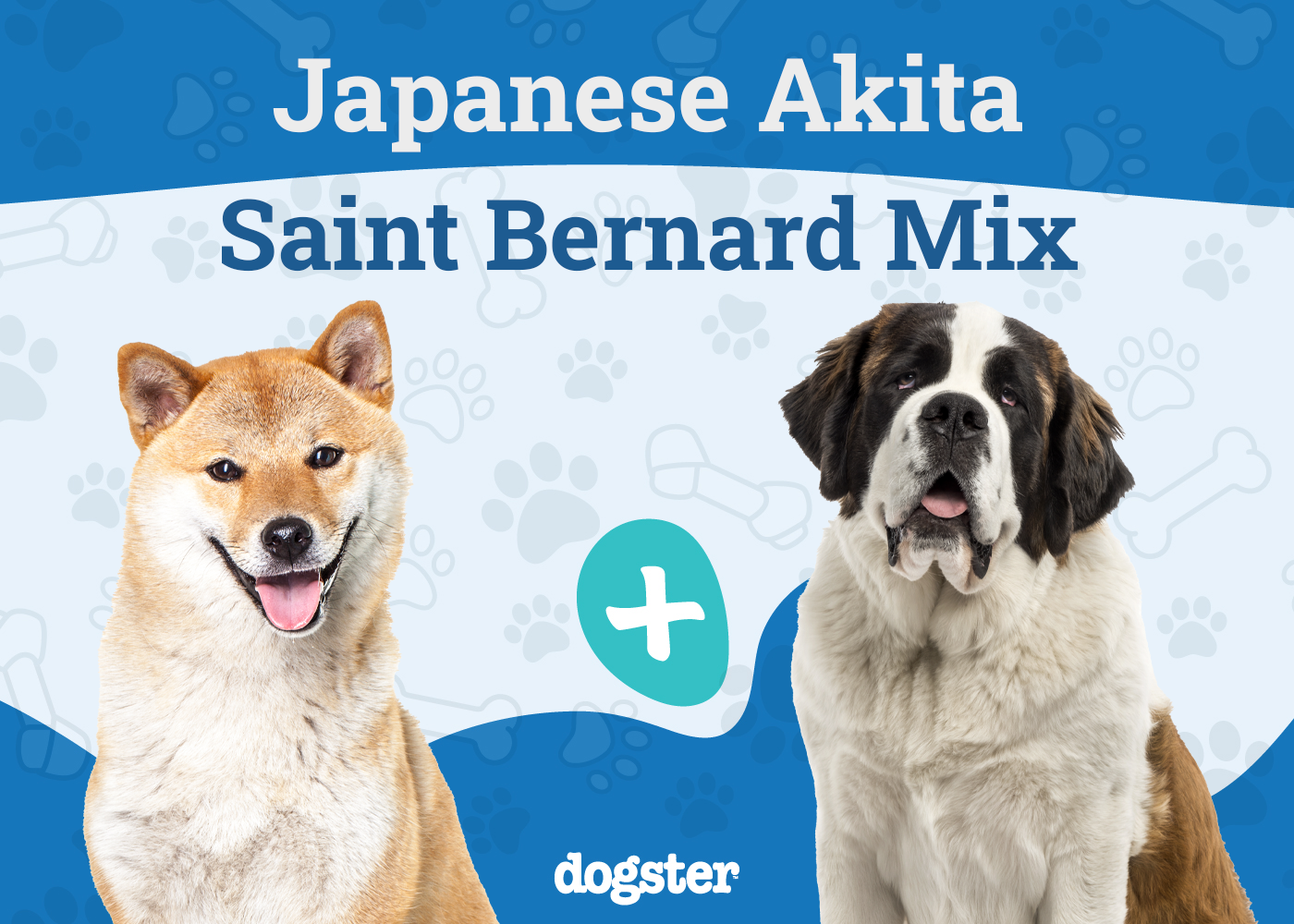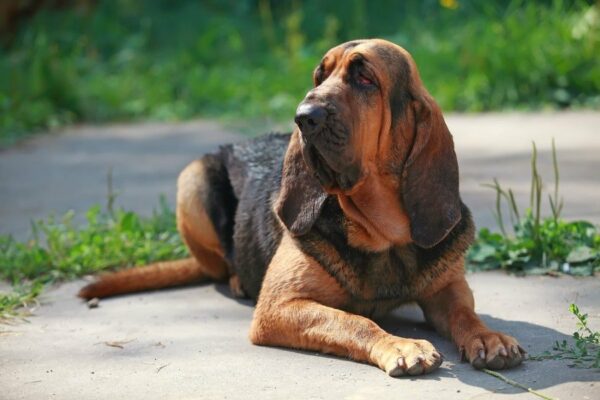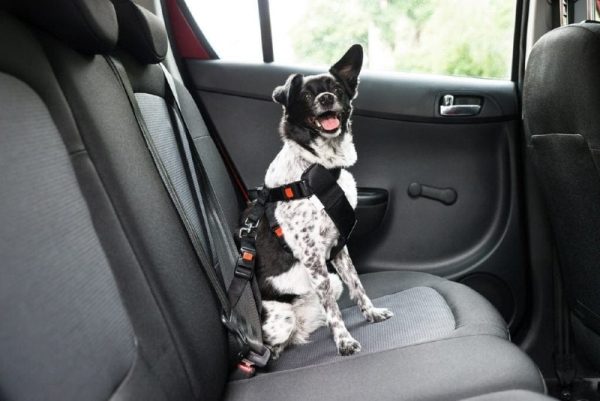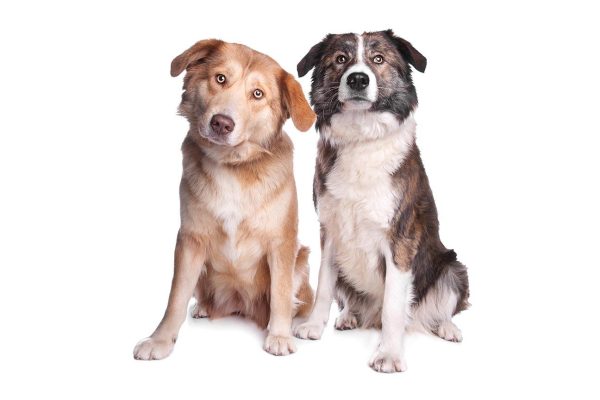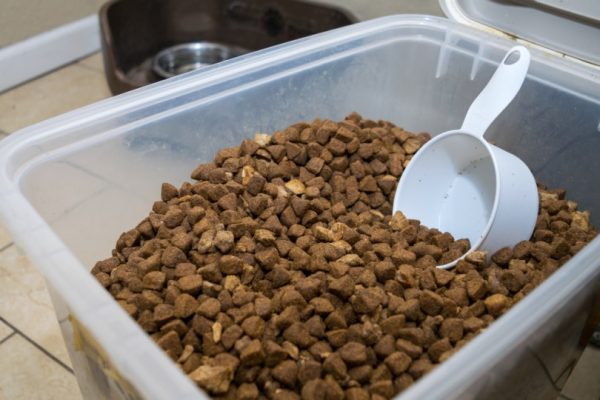In this article
View 8 More +The Akita Bernard is a cross between the Japanese Akita and the Swiss Saint Bernard. At first glance, you have a courageous dog with a steadfast devotion to their family. That makes them affectionate and loyal, giving them all the makings of an excellent watchdog and guardian. They are big and intelligent animals, best suited for experienced pet owners. Keep reading below to learn all there is to know about the majestic Akita Saint Bernard mix.
Breed Overview
Height:
28–36 inches
Weight:
90–175 pounds
Lifespan:
8–11 years
Colors:
Black, fawn, red, white, brindle, rust, orange
Suitable for:
Active families looking for a loyal dog that is protective and affectionate
Temperament:
Courageous, loyal, curious
The Akita is an ancient breed with a history going back thousands of years. They are related to other spitz-like dogs, such as the Chow Chow and Shiba Inu. The image of the Saint Bernard as a brave rescuer of lost travelers in the treacherous Alps is true. While the breed’s early history is unclear, many accounts exist from the Augustine monastery and hospice that kept and selectively bred these dogs for this work.
People associate both parent breeds with protection, whether as a symbol of good health or a companion to the monks living in challenging conditions. The Akita Bernard brings these traits together in a handsome dog that is devoted to its family.
Akita Bernard Characteristics

Akita Bernard Puppies
Akitas and Saint Bernards are relatively popular breeds with the American Kennel Club (AKC), which may make finding an Akita Bernard puppy challenging. Of course, a mixed breed does not guarantee a 50-50 mixture of the two parents. However, the two share many traits.
The Saint Bernard is the larger of the two and is nearly twice the size of the Akita. We suggest asking to see the mother and littermates to get a relative idea of how big your pup may get. We don’t recommend getting a puppy under 8 weeks. Separating them too early can make them more prone to fearfulness as adults. That’s problematic when considering how large these dogs can get. They need an experienced owner as it is, without this added burden.
Akita Bernard Breed Origin & History
The history of the Akita Bernard is unknown, without the paper trail that official recognition would offer. Undoubtedly, individuals with pet-quality animals selectively bred the parent breeds. The AKC recognized the Saint Bernard in 1885. Despite its longer history, the organization didn’t bestow this status on the Akita until 1972.
We can speculate that people developed this mixed breed during the 1980s and 1990s when designer dogs became the rage with the Labradoodle. The parent breeds both have admirable qualities. It’s worth noting that no major hybrid dog registry recognizes the Akita Bernard. That puts the responsibility on you to research the parent breeds and vet the seller before buying a puppy.


Temperament & Intelligence of the Akita Bernard
The Akita and Saint Bernard are intelligent animals, fitting for their roles. People originally selectively bred the former as bear-hunting dogs. Sadly, it later evolved into fighting, which led to their larger size and characteristic conformation. Their history took a dark turn with the military’s use of these animals for their fur during World War II. Devoted enthusiasts resurrected the pup to their former glory.
The Saint Bernard’s history isn’t as clear. Some suggest the breed is a descendant of the Molossers of the ancient Greeks because of the animal’s Mastiff-like head. Reliable documentation of them rescuing people didn’t appear until the late 17th century.1 The result is that this job requires a strong and fearless dog with excellent problem-solving skills.
Are These Dogs Good for Families? 🧑🧑🧒
The Akita Bernard is a loyal pet that’s friendly and affectionate. Nevertheless, we don’t recommend them for families with small children if just because of their massive size and potential for nippiness. It’s unwanted behavior that you must curb early. This pup also doesn’t tolerate being alone well, making an active household ideal.
Does This Breed Get Along With Other Pets? 🐶 😽
We don’t recommend the Akita Bernard in homes with other pets because of the parent breed’s dog fighting history. This breed also has a keen prey drive and will likely chase an animal fleeing from them. Remember that this dog has a protective nature and will defend family members from perceived threats, even from other pets.
Things to Know When Owning an Akita Bernard
The Akita Saint Bernard mix will thrive in a home with a large, fenced-in yard versus an apartment. This dog needs plenty of exercise and the mental stimulation it offers. This pooch prefers being around people and can be destructive if left alone for long periods. Separation anxiety is a concern in these cases. As large as this dog is, they are sensitive at heart and won’t respond well to harsh words or punishment.
Owning any pet is a financial commitment and responsibility. Ensure that you and your family are ready to shoulder these duties before getting an Akita Bernard. They begin the day you bring home your pup with early socialization and training.
Food & Diet Requirements 🦴
Proper nutrition is the foundation of good health. Giving your puppy food formulated for their life stage and size is imperative. After all, your Akita Bernard has a lot of growing to do. You should plan on feeding your pet three to four times daily. We suggest making it a routine to help you monitor your dog’s intake. We don’t recommend free feeding since it can make it hard to gauge.
You can cut back to twice daily once your dog reaches adulthood. Large breeds take longer to mature than small ones, so we suggest discussing your pet’s diet and the transition to an adult food with your vet. The parent breeds don’t have a propensity for obesity. Nevertheless, we recommend monitoring your pup’s body condition.
If you need to speak with a vet but can't get to one, head over to PangoVet. It's an online service where you can talk to a vet online and get the personalized advice you need for your pet — all at an affordable price!
Exercise 🐕
The Akita Bernard is moderately active. You should walk your dog daily for exercise and mental stimulation. This dog will enjoy this interaction with you and your family members. After all, both parent breeds are in the AKC’s Working Group. This pooch is happiest when they have a job, and it’s an excellent way to ensure their mental well-being.
Training 🦮
Early training and socialization are imperative for the Akita Bernard. They are large, powerful animals that need this attention to make them good pets. You should expose your pet to various situations and experiences. That includes introducing them to different people to keep their guardian instincts in check. Consistency and positive reinforcement are critical during their training.
Grooming ✂️
Weekly brushing is essential whether your dog has the Saint Bernard’s short coat or the denser Akita fur. It’s also a good time to check their ears and nails, ensuring the ears are kept clean and the nails aren’t clicking on the floor when they walk. Also, while it isn’t usually an issue with Akitas, Saint Bernards drool. So, depending on the animal’s genetics, keeping a towel handy when interacting with your pet might be a good idea.
Health and Conditions 🏥
The Akita Bernard is susceptible to many of the joint conditions encountered by large breeds. A reputable seller will conduct pre-breeding screening and DNA testing as applicable. We don’t recommend buying from an individual who doesn’t take these recommended precautions.
- Eye problems
- Ear infections
- Hip dysplasia
- Elbow dysplasia
- Bloat
- Degenerative myelopathy

Male vs. Female
The size difference between males and females is formidable. Depending on the dog’s genetics, it can be as much as 100 pounds. It underscores the need for early training to manage a large animal. Nonetheless, either sex will make a delightful pet. The dog’s upbringing and environment have the most significant impact on their personality and temperament. Daily activity is indeed a major factor.

3 Little-Known Facts About the Akita Bernard
1. The Akita Bernard is an excellent working or guard dog.
Since both parent breeds are large dogs, the Akita Bernard typically grows into a giant-sized dog, often weighing between 80–150 pounds or more. They are strong and muscular, making them excellent working or guard dogs. The Akita Bernard inherits the loyalty of the Akita and the protective instincts of the Saint Bernard, making them good guard dogs with proper training.
2. They are intelligent but stubborn.
The Akita Bernard is highly intelligent, but they can also be strong-willed. Training requires consistency, patience, and positive reinforcement. Early socialization is essential to ensure they are well-mannered and obedient. Akita Bernards aren’t the ideal option for first-time dog owners, since consistent training and patience will be much needed to successfully train one of these dogs.
3. Akita Bernards thrive in cold weather.
Both the Akita and the Saint Bernard are ideal dogs for cold temperatures, making the Akita Bernard an excellent dog for snow and cold environments. The Akita’s thick double coat and the Saint Bernard’s history as a mountain rescue dog mean this hybrid can handle harsh winters with ease.

Does the Akita Bernard Make a Good Pet?
The Akita Saint Bernard mix is a loyal animal and protective of its owners. They are intelligent, albeit with an independent streak that comes from the work the parent breeds did. The Akita Bernard can be a large dog, making this pup a better choice for experienced individuals who can handle a pet of this size.
Being protective also means the Akita Bernard is best suited in a single-dog household. They have a keen prey drive with the brawn to back up their infrequent but well-timed barking. These dogs can make good pets for families and households who understand their unique needs. This pooch won’t thrive if left alone a lot. They need human interaction to be good pets.

Conclusion
The Akita Bernard is a striking animal because of their size and unique features. You can’t help but notice this dog. The journey of each of the parent breeds has brought loyalty, courage, and resilience to the dog. However, this pooch needs an experienced owner who can make the necessary commitment to training and socialization. They can make an excellent canine companion for these individuals.
See also:
- Akbash Pyrenees (Akbash & Great Pyrenees Mix): Info, Pictures, Care & More
- Afghan Sheepdog Breed: Info, Pictures, Care Guide & More
Featured Image Credit: (L) Rita_Kochmarjova, Shutterstock | (R) Elena Nechiporenko, Shutterstock
